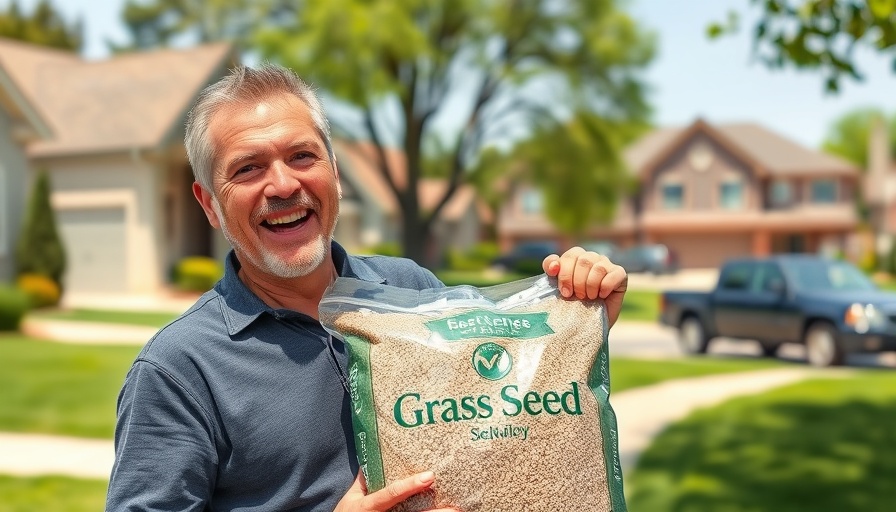
Understanding Bermuda Grass and Its Invasive Nature
Bermuda grass, a warm-season grass, is often admired for its resilience and aesthetic appeal, but for property owners seeking a lush yard of cool-season grasses like Kentucky bluegrass, it can quickly become a nuisance. Known for its aggressive growth, Bermuda grass competes ruthlessly with other grass types, leading to unsightly patches and bare spots. If you're a new homeowner or a DIY enthusiast searching for effective landscaping solutions, understanding how to manage this tenacious variety is crucial to achieving a well-manicured lawn.
In How To Kill Bermuda From Cool Season Grass, the discussion dives into effective methodologies for managing undesired grass, which sparked deeper analysis regarding lawn care solutions.
The Pylex Solution: A Targeted Approach
In the quest to eradicate unwanted Bermuda grass, Pylex herbicide has emerged as a powerful ally. Designed specifically for cool-season grasses, this boutique product effectively targets Bermuda while minimizing harm to your desired plant types. As demonstrated by Brian from Turanic, using Pylex requires precision and timing. The application process typically involves a careful mix with water and should be done during cooler parts of the day to avoid damaging your lawn.
Timing Is Everything: When to Apply Herbicides
The effectiveness of Pylex is not instantaneous; it requires persistence and strategic timing. Ideally, herbicide applications should begin in mid to late summer, allowing for multiple treatments as the Bermuda grass gradually gives way. Brian explains that patience is key—marked changes may take days to weeks to become visible. This is especially critical for homeowners in regions with fluctuating seasonal conditions like North Carolina, where weather influences grass growth cycles.
Maximizing Results: Best Practices for Weed Control
To optimize weed control, follow these best practices: avoid mowing before applying any herbicide and be cautious about mowing afterward. Waiting a few days allows the herbicide to absorb effectively, which is crucial for achieving long-lasting results. For those living in areas like Charlotte, Raleigh, or Asheville, adapting these practices can yield better lawns and a more pleasing curb appeal.
Future Trends: Eco-Friendly Lawn Care
As we strive for lush, low-maintenance yards, future landscaping trends are leaning towards eco-friendly solutions. Homeowners can look into xeriscaping, which incorporates drought-resistant plants, or explore native plant landscaping ideas for a sustainable approach that also supports local ecosystems. Innovative landscaping contractors in North Carolina are increasingly offering services that highlight pollinator-friendly gardens, which not only beautify your property but also promote biodiversity.
Overcoming Common Lawn Care Misconceptions
Many homeowners believe that simply applying a herbicide will resolve their Bermuda grass problems entirely. However, as highlighted in Brian's experience, it often requires multiple applications and ongoing monitoring. They might also assume that Bermuda grass will disappear after one treatment, which is rarely the case. Understanding these challenges is imperative, especially for homeowners investing time and money into maintaining their yards.
Taking Control of Lawn Care: Your Next Steps
For those struggling with Bermuda grass encroachment, your first step is assessing the verdant landscape and identifying how much of it is Bermuda. Once identified, carefully follow the application guidelines for Pylex, monitor the results, and adapt as necessary. This methodical approach can help facilitate a successful transition to a lush lawn dominated by cool-season grasses.
As we look ahead, investing in a resilient lawn begins with understanding the dynamics of your property and the best practices for weed control. Engaging with local landscaping contractors can yield tailored advice and solutions for your unique geographic challenges.
Emerging landscaping trends emphasize a future of sustainability, informed choices, and responsible lawn care practices. Adopt these principles, and you can create an inviting outdoor space that enhances your home's value and contributes positively to the environment.
 Add Row
Add Row  Add
Add 




Write A Comment